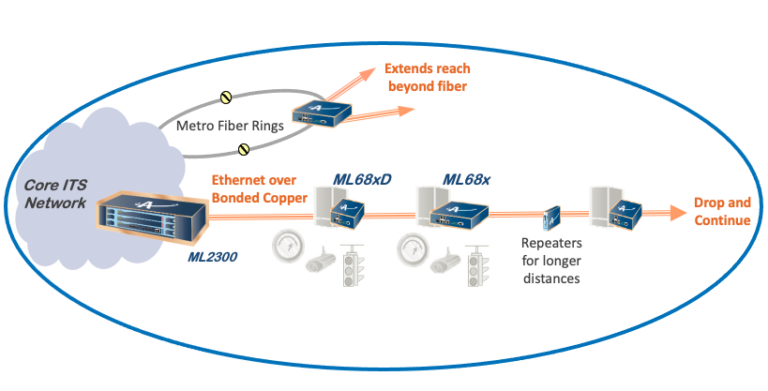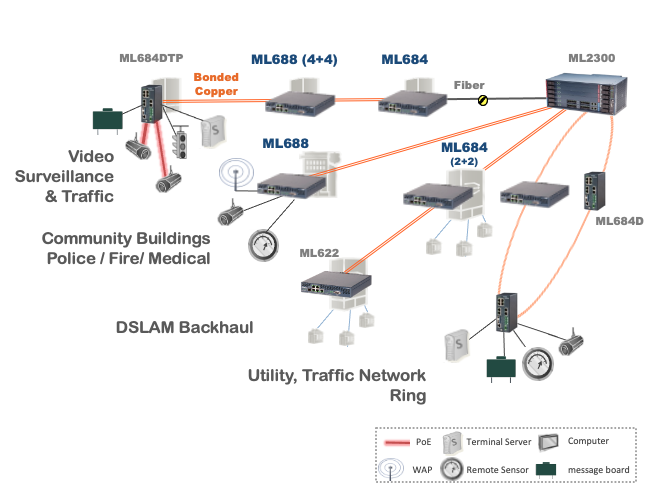Modernize. Digitize. Protect.
With Actelis, Montgomery County Becomes a National Model for Intelligent Traffic Systems
Background
Major Washington DC Suburb Keeps the Traffic Moving with Actelis Intelligent Traffic System (ITS)
Montgomery County, Maryland, covers an area of approximately 500 square miles and has a population of over one million people, including many dignitaries who work on Capitol Hill. The county is also home to some of the leading biotechnology companies, corporations, and federal agencies in the USA. The Actelis intelligent traffic system has become a national model for transportation management along the 4,500 center lane miles, 1,000+ miles of emergency roads, 50 miles of interstate, and 4,000 neighborhood roads.
The Montgomery County Department of Transportation (MCDOT) is responsible for traffic flowing smoothly along all these roadways. To achieve this, the MCDOT must ensure that 800 traffic signals, sensors and surveillance cameras function in harmony, all managed from the county’s centralized Traffic Operation Center (TOC).
The Challenge
The ITS Search Begins When an Outage Makes National News
“We’ve been using a real-time centralized traffic management system for decades,” said Michael Kinney, the senior engineer at MCDOT. “However, the network was nearing the end of its useful life and the old system lacked the required resiliency. If a single component failed, for example, some or all traffic signals lost coordination, disrupting the flow of traffic.”
Things came to a head, when a system-wide outage lasted two days and made national news headlines.
“The rush hour commute was severely impacted and gridlock lasted all day,” Kinney said. “In addition to the inconvenience to commuters, ensuing traffic jams wasted gas and resulted in added CO2 emissions. It was time to replace the county’s traffic management system.”
Of course, upgrading to an intelligent transportation system had to be doable within the available budget.
Customer’s Requirements
Leverage Existing Hybrid Fiber-Copper Infrastructure and Simplify Management
- Must eliminate single points of failure
- High speed connectivity with state-of-the-art network security
- Temperature hardened for fire zones and extreme climate
- Leverage copper with easy migration to fiber when available
- Quick, easy deployment with no roadway disruption
- Managed Ethernet Switches
- Flexible typologies and Power over Ethernet (PoE)
- Optimized for video
- Must not require additional staff or resources
- Must be standards compliant
Fortunately, the county already had a communications infrastructure of twisted pair-copper covering hundreds of miles. The MCDOT had also made an ongoing investment in building a fiber ring, so any upgrade to the system had to make use of available resources and re-use this existing copper and fiber.
Montgomery County’s traffic cameras, intersection controls and other elements of the traffic management system are operated by just 17 employees. Since 1980, the MCDOT has doubled the number of intersections and added 200 cameras. The number of personnel, however, remained constant. A key specification for the new system was to reduce employee trips to manually adjust signal controller timings.
Solution
Montgomery County Selects Actelis Intelligent Traffic System with Built-in Redundancy
The MCDOT undertook a thorough analysis of the current traffic management system and available solutions. It developed a two-year, and a six-year plan, and set a deadline for retiring the old system.
After the test and evaluation of several systems from a variety of vendors, the MCDOT selected Silicon Valley-based Actelis to build a network for the county’s new intelligent traffic system.
Environmentally Hardened EADs
The Actelis system met MCDOT’s specific technical and operational requirements, including the ability to maintain integrity in extreme cold and hot weather, rain and snow, and after lightning strikes. Montgomery County selected environmentally hardened ML624i and ML688 Ethernet Access Devices (EADs).
Guaranteed Redundancy to Eliminate Single Points of Failure
The EADs had to bond multiple pairs of copper to deliver the necessary bandwidth to communicate with the controller and provide the required redundancy. Because Actelis provides built-in redundancy with no single point of failure, it was an important differentiator for MCDOT. If one pair failed, the network connectivity would not be lost using the Actelis solution.
Compatible with Existing Equipment and IGMP Protocols
The equipment is also compatible with Internet Group Management Protocol (IGMP) snooping, meaning it can logically segregate network traffic between the units and the controller, enabling more efficient bandwidth management.

Modernize. Digitize. Protect.
Actelis enables fast deployment of secure, fiber grade services over hybrid fiber-copper networks
Hybrid Fiber-Copper Network Interface
The EADs and aggregation switches support both GigE fiber and high-speed Ethernet-based copper interfaces, meaning that Montgomery County’s fiber ring is connected to Actelis equipment on one unit, while copper is used to connect the equipment to the signal cabinets.
State-of-the-Art Data Management and Network Security
The new equipment supports VLAN tagging, which allows separation of different streams of traffic. This ensures that traffic from signal controllers follows a different virtual path than a stream of traffic for WiFi access. MAC address filtering and IP access control allow Montgomery County to prevent unauthorized access to the network. In addition, support for Secure Shell (SSH) enables strong authentication and prevents malicious attacks such as IP spoofing, IP source routing and DNS spoofing.
Simplified Provisioning, Monitoring and Management
The MetaASSIST EMS is a Carrier-class distributed element management system (EMS), which enables the Actelis product family to integrate smoothly into existing network management systems via standard interfaces. It also enables centralized real-time planning, provisioning, monitoring and management of networks of multiple systems. The MCDOT uses the combination of these systems to collect data, report on SLA performance and troubleshoot hundreds of network elements across a large geographical area.
Real Time Signal Adjustments Keep Traffic Flowing
The final topology of the network leveraged a hybrid communication network using fiber to create a ring and running laterals to the traffic controllers. The centralized command and control system enable the county to build timing plans that can be used well into the future. They also enable technicians to make signal timing adjustments – up to 60 times a day – to fine-tune the signal timing to account for accidents or roadworks.
“A practical application of this capability is if a traffic incident takes place on I-495, I-370 and I-270 (three major highways running through the county) as well as on any of the surface streets, TOC operators can quickly divert drivers to side roads and enable traffic to continue flowing smoothly,” says Kinney.
With 850 network elements installed, Montgomery County has not encountered any significant issues with the equipment and the solution has proven to be very reliable.
Even though the DOT’s 17 traffic technicians are still very busy managing traffic across a large county, the new network has not required additional staff. In fact, the MCDOT reports that the resiliency of the new equipment and its ability to automatically recover from outages has reduced the burden placed on technicians.
Actelis Benefits
- Fiber-grade performance
- Highly secure transport
- Cost efficient, scaleable
- Quick, easy deployment
- Easy upgrade path to fiber networks
- Utilize existing copper facilities
Modernize. Digitize. Protect.
Actelis provides secure and resilient broadband communications networks for Smart Cities- ITS, IoT, Industrial IoT and muni Wi-Fi.

Modernize. Digitize. Protect.
With Actelis, Montgomery County becomes a model for overall ITS efficiency.
Conclusion
With Actelis Montgomery County Becomes a Model for Intelligent Transportation Systems
Montgomery County’s ITS has become a model for traffic management solutions. It regularly hosts tours for various cities, counties and DOT representatives to demonstrate how it has successfully upgraded legacy systems while making optimal use of the existing network infrastructure and human resources.
The success of this first phase has led to plans to increase safety and reduce public transportation journey times by instituting transit signal priority to give buses extra green light time. Since the upgraded network can carry much higher volumes of data, the DOT may replace school flashes currently operating with time-clocked devices that need manual adjustments every time the schedule changes, with devices that can be managed over the network. It is also looking to install sampling devices to detect traffic volume and speed.
“The ability to install and auto-manage the network allows the traffic engineers to focus on their core competency: improving the overall efficiency and effectiveness of the county’s traffic system,” says Kinney.
Related products

Actelis high density aggregation platforms simplify deployment, provisioning and management of ITS, smart city and IoT applications.

Actelis industrial Ethernet switches provide market leading reliability and are designed for flexible typologies and extreme environments.
With Actelis MetaAssist, network operators can rapidly deploy and scale while reducing operational expenses and complexity.
